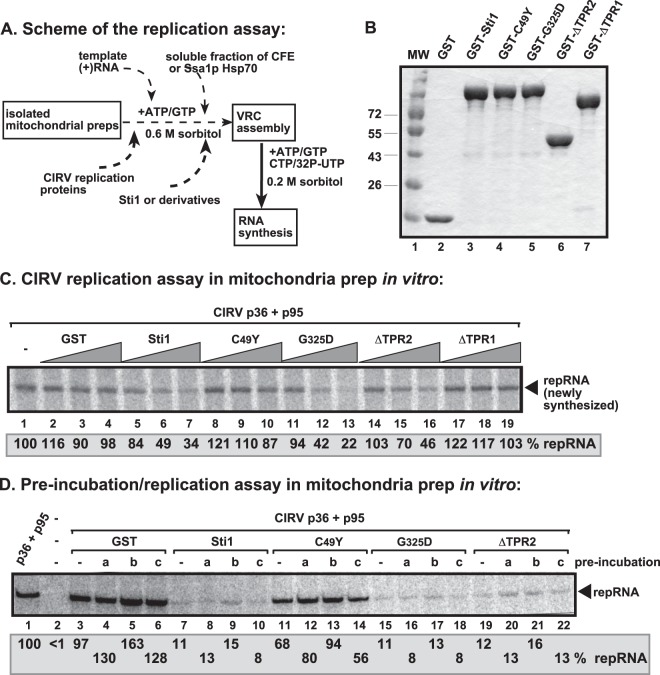FIG 7.
Functional TPR1 domain of Sti1p blocks CIRV replication in vitro. (A) Scheme of in vitro reconstitution of the CIRV replicase in yeast mitochondrial preparation. The purified GST-tagged Sti1p or derivatives, the purified recombinant CIRV MBP-p36 and MBP-p95 proteins and the TBSV-derived (+)repRNA were used in isolated mitochondrial preparations. (B) Coomassie blue-stained SDS-PAGE was used for analysis of affinity-purified GST-tagged Sti1 or derivatives. MW, molecular weight (noted on y axis; in thousands). (C) Denaturing PAGE analysis of the 32P-labeled repRNA products obtained in the replication assays with the isolated yeast mitochondrial preparation and the soluble fraction of yeast CFE that provided soluble host factors. The arrowhead indicates synthesized full-length repRNA. The replication assay with CIRV p36 and p95 (without added Sti1) was chosen as 100% (lane 1). The recombinant proteins were added in 8, 16, and 32 μM amounts. Each experiment was repeated. (D) CIRV mitochondrial replication assays were performed (see panel A) to test the effect of preincubation of various components. Lanes “a” show samples for which the purified Ssa1p Hsp70 (from the sti1Δ yeast strain) was preincubated for 10 min with a comparable amount of GST, GST-Sti1p, or mutants (from E. coli), while in lanes “b,” the MBP-p36/MBP-p95 of CIRV (from E. coli) was preincubated with Ssa1p. In lanes “c,” the MBP-p36/MBP-p95 of CIRV was preincubated with GST, GST-Sti1p, or mutants, while in lanes “-,” no preincubation was performed. In each experiment, we used comparable amounts of each component for preincubation that lasted for 10 min in the reaction buffer. After the preincubation step, we added the missing components and performed the CIRV replication assay (see panel A). Each experiment was repeated at least twice.

